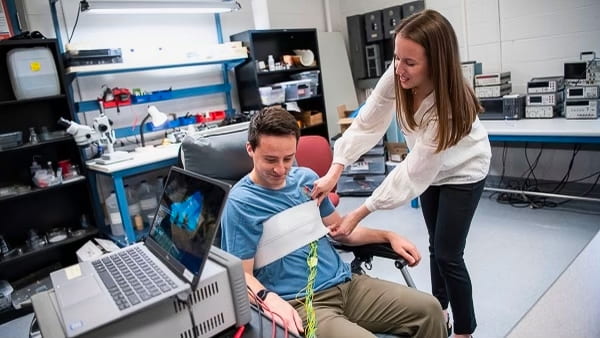
Allyanna Rice, a graduate fellow pursuing work on innovation technology regarding muscle atrophy, tests a device on an Ohio State student in the ElectroScience Laboratory. Credit: Logan Wallace | For The Lantern
The newest product out of Ohio State could have an out-of-this-world effect on muscle atrophy.
Allyanna Rice, a third-year Ph.D. student in electrical and computer engineering, and her fellow researchers constructed the first wearable device aimed at discovering and monitoring muscle atrophy — when muscle tissue deteriorates in strength given the absence of gravity — inspired by the goal to help astronauts who endure long periods of time in space, according to an article on the College of Engineering website.
According to a statement on muscle atrophy from NASA, lengthy journeys in zero gravity often cause muscle atrophy, and the lack of regular muscle usage on these trips is damaging and can eventually lead to long-term disability.
“The loss of muscle mass means a loss of strength that can be potentially dangerous if an astronaut must perform a strenuous emergency procedure upon re-entry into the Earth’s gravitational field,” NASA stated.
Rice said this invention is important because the current tissue of astronauts is only measured before and after their flight, so little is done to improve or monitor the muscle atrophy of those while in space.
Within the device, she said two antennae on the sleeve of the sensor serve as a receiver and a transmitter.
“The receiver will receive a signal from the transmitter where we can get information about body tissue such as the bone and then we also have these loops which are intended for monitoring muscle atrophy,” Rice said.
Rice said in the College of Engineering’s release that the sensor could be used by healthcare providers to help create treatment plans for patients. The release stated the sensor was validated by molds filled with ground beef that stimulated calf tissue demonstrated a 51 percent muscle loss in limb size.
Rice said in an email she currently holds a fellowship that allowed her the opportunity to work with NASA’s Johnson Space Center in summer 2022. She said visiting the center in Houston helped her visualize the importance of her work.
“Feeling the excitement there, hearing from their experts, it left me inspired,” Rice said. “It made me feel like what I’m doing may have an actual impact in the future.”
Rice said she executed her work through the help of Asimina Kiourti, an associate professor in the College of Engineering at Ohio State, Rice’s guide who already works closely with researchers from NASA in her lab.
Kiourti said in an email it has been “exciting to see [Rice] grow.”
“She’s been teaching me. She’s been teaching her other students about the parts and aspects that we didn’t know,” Kiourti said.
Kiourti said Rice’s ability to experience the processes of NASA was a great opportunity, and the organization’s visionary work assists students in seeing the bigger, inspiring picture of this research.
“You just don’t see like five or 10 years down the road, you see decades down the road. So it’s very exciting and inspiring for all of us,” Kiourti said.
Rice said she plans to return to NASA this summer to continue researching and learning with two years remaining in her fellowship. She also said she hopes to apply her work to earthly issues — including bone loss through osteoporosis, aging, cancer detection and tumor classification.
“These real-world collaborations have been such a great experience. It’s made what I’m doing feel more relevant,” Rice said. “I never expected when I came to Ohio State that I’d be working closely with NASA but it’s been incredible.”


